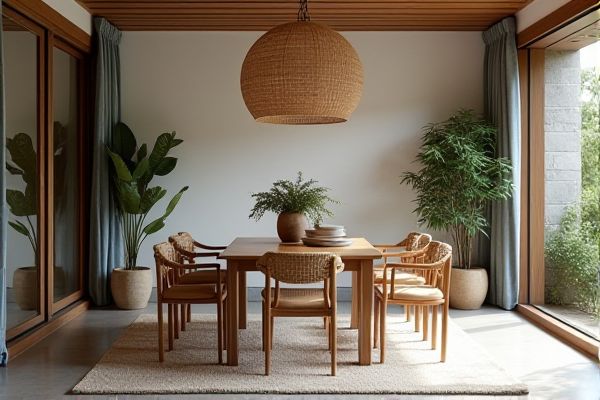
Low tables create a relaxed and cozy atmosphere on your terrace, perfect for casual gatherings and lounging, while high tables offer a more formal setting suited for dining and standing conversations. Explore the rest of the article to discover which table height best complements your outdoor space and lifestyle.
Table of Comparison
| Feature | Low Table | High Table |
|---|---|---|
| Height | Typically 12-18 inches | Typically 28-36 inches |
| Seating Style | Floor cushions or low chairs | Standard chairs or bar stools |
| Use Case | Casual, lounge, relaxed socializing | Dining, work, standing support |
| Space Efficiency | Great for compact, cozy terraces | Better for open terraces with ample standing space |
| Comfort | Comfortable for lounging, less ergonomic for dining | Ergonomic for eating and working |
| Style | Casual, modern, minimalist | Formal, functional, versatile |
| Material | Wood, rattan, bamboo | Metal, wood, composite |
| Maintenance | Easy to clean, requires occasional polishing | Durable, often weather-resistant finishes |
Understanding Terrace Furniture Needs
Low tables on terraces create a relaxed, casual atmosphere perfect for lounging and socializing, while high tables offer a more formal setting suited for dining and standing gatherings. Your choice should consider the terrace size, intended use, and comfort preferences to ensure the furniture complements the outdoor environment. Ergonomics and style balance between low and high tables enhance the terrace's functionality and aesthetic appeal.
Low Table vs High Table: Core Differences
Low tables provide a cozy, relaxed seating arrangement ideal for casual gatherings on terraces, promoting comfort and intimacy. High tables elevate the seating experience, offering better visibility and facilitating active social interactions or dining. Your choice depends on the terrace size, intended use, and the atmosphere you want to create.
Space Utilization: Maximizing Terrace Area
Low tables optimize terrace space utilization by allowing seating arrangements like floor cushions or poufs, which occupy less vertical and horizontal space, creating a more open and flexible area. High tables require chairs, increasing the footprint and reducing the number of people who can comfortably use the terrace simultaneously. Choosing low tables enhances spatial efficiency, promotes a relaxed atmosphere, and maximizes usable terrace area for social gatherings or leisure activities.
Comfort and Ergonomics: Seating Height Matters
Low tables on terraces offer a relaxed seating experience, allowing your body to recline comfortably with cushions or floor seating, promoting a casual and cozy atmosphere. High tables require chairs with proper support, encouraging an upright posture that can reduce strain on the back and neck during longer gatherings. Choosing the right table height enhances comfort and ergonomics, ensuring your terrace setup suits your preferred seating style and duration.
Versatility for Terrace Activities
Low tables offer enhanced versatility for terrace activities by providing a comfortable surface for casual dining, relaxation, and social gatherings, easily accommodating floor seating or bean bags. High tables support versatile use by enabling standing meetings, bar-style dining, and easy access for bar stools, ideal for mingling and cocktail parties on terraces. Choosing between low and high tables depends on the preferred terrace activity style, seating arrangements, and space optimization goals.
Social Interaction: Setting the Ambience
Low tables on terraces create an intimate atmosphere that encourages close, relaxed conversations and fosters social bonding, ideal for cozy gatherings and casual chats. High tables promote a lively and dynamic environment, allowing guests to stand or sit while mingling easily, which enhances movement and interaction during social events. Choosing between low and high tables depends on whether the goal is to cultivate a laid-back ambience or an energetic social scene on the terrace.
Weather Resistance and Material Choices
Low tables made from weather-resistant materials such as teak, treated aluminum, or synthetic rattan provide excellent durability against rain and sun exposure, making them ideal for outdoor terraces. High tables often use powder-coated steel or weatherproof hardwoods like cedar, which resist corrosion and warping while offering a sturdy surface for elevated social settings. Your choice between low and high tables should consider the specific climate conditions and maintenance requirements for long-lasting terrace furniture.
Style Considerations for Modern Terraces
Low tables create a relaxed, casual vibe on modern terraces, encouraging social interaction and comfortable lounging. High tables, in contrast, offer a sleek, contemporary look ideal for standing gatherings or paired with bar stools to maximize space. Your choice influences the overall ambiance and functionality, balancing style with how you plan to enjoy your terrace.
Maintenance and Durability Comparison
Low tables designed for terrace use often require less maintenance due to their compact height and reduced exposure to environmental elements, making them easier to clean and less prone to wear. High terrace tables, while offering greater usability for standing or bar-style seating, typically demand more frequent upkeep as their elevated structure catches more wind and debris, increasing the risk of damage and the need for protective coatings. Durability in both types depends heavily on material choice, with weather-resistant options like treated wood, metal alloys, or synthetic resin enhancing longevity under outdoor conditions.
Making the Right Choice for Your Terrace
Choosing between a low table and a high table for your terrace depends on your space and intended use; low tables offer a relaxed, casual vibe ideal for lounging areas, while high tables promote social interaction and are perfect for standing or bar stool seating. Consider the height of your terrace walls and the view to maximize comfort and functionality, ensuring your furniture complements the environment and enhances your outdoor experience. Your decision should balance aesthetics with practicality, creating a terrace setup that invites both relaxation and conversation.
 homyna.com
homyna.com